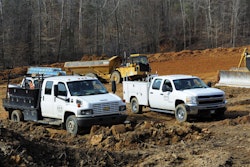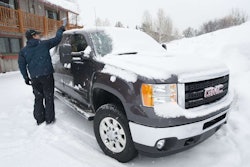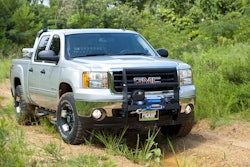MAX AMPS: High-Output Alternators
 Choosing the right high-output alternator for your harder working pickups
Choosing the right high-output alternator for your harder working pickups
by Jim Allen (photos by the author or courtesy of the manufacturers)
Snowplows, winches, inverters, accessory lights, air suspensions, on-board compressors, fuel/lube dispensing equipment, multiple batteries and high-output communications/sound systems are all common upgrades found in today’s working pickups.
If pickups in your fleet already have – or you are planning on adding – such work necessaries down the road, seriously consider including a high-output alternator into the upgrade budget.
The extra expense of upgrading to a high-output alternator could be trouble-averting money well spent.
A few of you may have already experienced that magic moment when, after long hours operating with a lot of upgrades that draw electrical power, the truck battery is nearly dead and you are stuck on the jobsite waiting for help to arrive.
The problem could be either the stock alternator doesn’t have the output to keep up with the demand – or it has failed due to duty-cycle problems related to high-draw electrical loads.
ALTERNATOR KILLERS
An OE alternator is generally designed for a short duty-cycle supplying the truck’s factory electrical load. Its capacity to handle additional electrical loads from upgrades is small.
So long periods operating at its max output to try and meet those electrical demands create a lot of heat – and electrical components like alternators don’t like high heat.
Also, because you may be drawing on the battery more often in these cases, the repeated partial discharges may shorten the battery life.
So, high electrical demand can prematurely kill both the alternator and the battery.
Such electrical problems can be easily resolved by replacing the alternator with one of higher output and/or a higher duty-cycle capacity.
AMP IT UP
To find out how much alternator output is needed, you’ll need to do a little amp counting: Add up the current draw for all accessories running at one time and determine at what rpm that will be (i.e. idle or higher).
An accessory’s current draw specifications can usually be found in the instructions for the product, on a tag affixed to the equipment itself, with a quick search on the web or via a call to the manufacturer.
Choose an alternator with a maximum output greater than than the total amp draw at that rpm.
How much more? This is where duty-cycle comes into play.
Duty-cycle boils down to the ability of an alternator to cool itself at high output and the ability of the components within the alternator to withstand the heat.
If you need 100 amps continuously at a specific rpm, for example, get an alternator that produces 160 amps at that speed. For many in the heavy construction, DOT and utility trades, the most important consideration is alternator output at idle.
Most OE alternators deliver below 50 percent of their maximum output at idle speeds.
For example, the Ford 110-amp 6G alternator found on many 5.4L engines puts out max of amps at 2,000rpm. But it produces only about 47 amps at a 600rpm idle.
Conversely, a high-output Powermaster bolt-in replacement is producing 103 amps at 600rpm, 147 at 800rpm, 175 at 1,100rpm and more than 200 amps at 2,000 rpm. PowerBastards’ version provides 125 amps at idle and the full 250 amps at 1,200rpm.
Those are big performance differences between OE and aftermarket alternators.
Alternator output is tied in to its size as well. So bear in mind some fabrication may be required to make the high-output unit fit, especially if a large, continuous-duty alternator is installed.
OTHER CONSIDERATIONS
During an alternator upgrade, consideration must also be made for belts and power cables. Any given belt can only drive so many amps.
Usually, a single 3/8-inch V-belt can drive an 80-amp alternator; a single 1/2-inch V-belt about 120 amps; and dual 1/2-inch belts up to about 200 amps.
A four-rib serpentine is typically good for about 120 amps, six-rib serpentines can handle up to about 300 amps and 8-rib more than 400.
The output cable from the alternator and the ground wires must be sized according to alternator output as well. Obviously a wire designed for an OE 100-amp unit is not going to be able to handle 225 amps safely and you would make sure the cabling is sufficient for the draw all the way down the line, including the grounds. (Fine strand welding cable is preferred.)
Some alternators are tied in to the vehicle’s PCM (Powertrain Control Module) and those upgrades may require special electrical adaptation. Your alternator supplier should know those details and usually have kits or accessories available to cover all these bases and make the job easy.
The overall theme of upgrading to a high-output alternator is to think through the entire process.
Cold Amps
Snowplowing is one of the highest amp-draw scenarios a pickup might see. Not only are you running a snow plow pump, which can draw up to 400 amps, you are running lights, heater, wipers, auxiliary lights, radios, stereo and who knows what else, for long hours at a stretch.
 Without a charging system well prepped, at the end of a long night plowing, your battery could be partially or fully discharged and your OE alternator could go up in smoke at a young age.
Without a charging system well prepped, at the end of a long night plowing, your battery could be partially or fully discharged and your OE alternator could go up in smoke at a young age.
Snowplow packages often include higher-output alternators, as is the case with GM Hds. The stock standard alternator is 125 amps but the snowplow package has a 160-amp alternator with 6.0L engines and dual 125-amp alternators with the 6.6L Duramax diesel.
If you are buying a new pickup and plan on plowing or using it in other high-amp-draw situations, order the high-output alternator option that is often also available a la carte.
HOT ALTERNATORS FOR BIG LOADS








